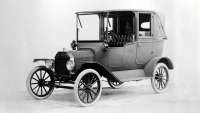Q: What is CVT transmission?
A: Let’s break this down into simpler chunks, because the CVT is a pretty complex piece of gear and one that’s increasingly popular in mass-market cars.
So, let’s start with what does CVT stand for? It’s an acronym for Constantly Variable Transmission (or Constant Variable Transmission).
As the name suggests, instead of fixed gear ratios like a conventional manual or automatic transmission, the CVT has a theoretically infinite range of possible ratios.
How do CVT transmissions work and how do they offer such a wide range of possible ratios? Because instead of gears with different numbers of teeth to produce the fixed ratios, the CVT uses a pair of conical drums (or pulleys) linked by a steel belt, or rope (for want of a better word).
As the car accelerates, the pulleys expand or contract, changing the diameter (sometimes minutely) of the part of the belt rides on. This effectively varies the gear 'ratio' in the process and allows the car to maintain the desired speed while keeping engine speed where it needs to be in terms of optimal fuel economy or power and torque production.
Think of it like a modern pushbike with 24 gears courtesy of a choice of three chain-wheels (on the pedals) and eight different sprockets (gears) on the rear wheel. But now imagine that instead of individual gears, those 24 options had no defined steps, just a spread of ratios.
.jpg)
Modern CVTs are computer controlled for efficiency but the principle is the same as the very first CVT that was used in a 19th century sawmill and the 1958 DAF 600 which was the first production example of cars with CVT transmissions.
But why would a carmaker switch to this transmission system when there’s really nothing wrong with the established automotive transmissions?
Basically, the CVT auto has the potential to improve efficiency and reduce fuel consumption over other popular transmission options. And it’s all because petrol and diesel engines have a sweet spot where they work most efficiently.
If, therefore, you can keep the engine working in that sweet spot (a particular engine speed) then it will do more with less fuel.
.jpg)
Because the CVT can infinitely vary its effective ratio, it can hold the engine in that sweet spot more of the time, instead of the conventional transmission’s fixed ratios dictating engine speed.
Early CVTs were limited by their ability to handle torque without the drive belt flying to pieces. This meant smaller, lighter, lower-powered cars were more suited to the CVT meaning it was shunned by many carmakers for decades.
But new materials and technology have meant the CVT is now much more robust and widely used. Many Japanese makers have embraced the tech for their mid-sized SUVs and the CVT gearbox works nicely with a hybrid driveline which, like the gearbox itself, is aimed at high efficiency over all else.
When it comes to take up of the CVT transmission Nissan, Subaru and Toyota are all leaders. Clearly, these manufacturers have addressed what is CVT transmission technology’s biggest hurdle.

The downside of the CVT auto is that it can feel a bit alien to drive. Instead of the car and engine accelerating together, the CVT uses a different approach, allowing the engine to rev up to its efficiency sweet spot and then altering its ratio until the car catches up with the motor. Keener drivers don’t tend to like the sound and sensation this produces.
If you’re thinking about a car with a CVT transmission, you need to drive it in a range of conditions to make sure you can live with its habits. There’s also a fair bit mechanically going on with a CVT meaning a service record is essential (as it is with any car, of course).
So, what’s the next step? What is CVT in cars going to look like moving forward? Well, like a lot of other transmissions, the battery-electric driveline will make a lot of them, if not actually obsolete, at least on the endangered list.
EVs have proved that they only require transmissions with a single ratio; two ratios at the most. So it’s a bit hard to see many carmakers bothering with an expensive, technically complex thing like a CVT when they don’t really need it.
On the other hand, electric cars with range-extending ICE engines might be very well served by the CVT’s ability to squeeze a bit more from every litre of fossil fuel.





.jpg)
.jpg)



.jpg)
.jpg)

.jpg)
.jpg)

_0.jpg)
.jpg)
.jpg)
.jpg)



.jpg)



